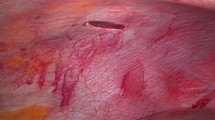Summary
BACKGROUND: Penetrating abdominal trauma (PAT) poses a significant challenge to trauma surgeons. There is no doubt that persistent hemodynamic instability or signs of peritoneal irritation warrant immediate laparotomy. If the patient is hemodynamically stable and has equivocal abdominal examination findings, diagnosis may be obtained by laparoscopy. METHODS: The goal of this article is to evaluate the role of laparoscopy in the management of PAT. RESULTS: Patients with penetrating trauma to the thoracoabdominal and anterior abdominal wall are good candidates for laparoscopic evaluation. The peritoneal cavity and its contents, including the retroperitoneal space, can be thoroughly examined easily and safely. The main benefits of laparoscopy include the reduction of nontherapeutic laparotomies, identification of mostly intra-abdominal injury, and provision of potential therapy for some cases. Diagnostic laparoscopy has a high overall diagnostic accuracy, reduced morbidity, and shortened hospital stay and is also cost-effective. While laparoscopy has some limitations in the diagnosis of hollow viscus injury, it can detect and repair diaphragmatic injuries accurately and exclude the risk of nontherapeutic laparotomy due to a nonbleeding injury of the solid organs. CONCLUSIONS: The use of laparoscopy as a diagnostic or therapeutic method in patients with PAT is reserved only for hemodynamically stable patients and uncertain findings of peritonitis. Laparoscopy is an efficient and effective diagnostic tool when used by a well-trained surgeon. With experience, an increasing number of surgeons are using laparoscopy as an additional diagnostic tool for PAT in stable patients. With more experience and skills, laparoscopy may be used more therapeutically in selected patients. Minimally invasive surgery has already established itself as a useful tool in the management of PAT. The future seems to be promising for this field of surgery by innovative developments in computer technology and robotic systems.
Zusammenfassung
GRUNDLAGEN: Penetrierende Abdominaltraumen (PAT) stellen eine große Herausforderung für die Traumachirurgen dar. Es besteht keine Frage über die Notwendigkeit einer notfallsmäßigen Laparotomie bei Patienten, die eine anhaltende Kreislaufinstabilität oder Zeichen einer Peritonitis aufweisen. Wenn die Patienten hämodynamisch stabil sind und eine entsprechende abdominelle Symptomatik bieten, kann die diagnostische Laparoskopie angewendet werden. METHODIK: Das Ziel dieses Artikels ist die Evaluierung der Rolle der Laparoskopie im Management der penetrierenden Abdominaltraumen. ERGEBNISSE: Patienten mit einer penetrierenden Verletzung an der Abdominalwand oder des thorakoabdominalen Überganges profitieren von einer laparoskopischen Exploration. Die Abdominalhöhle einschließlich des retroperitonealen Raums kann sehr gut und effektiv exploriert werden. Der Hauptvorteil der Laparoskopie liegt in der Reduktion der Zahl an nicht therapeutischen Laparotomien und in der exakten Diagnostik der intraabdominellen Verletzungen. Die Laparoskopie kann unter Umständen auch eine therapeutische Option darstellen. Die diagnostische Laparoskopie hat eine hohe Genauigkeit, verhilft zur Reduktion der Morbidität, verkürzt den Krankenhausaufenthalt und sie ist kosteneffektiv. Während die Laparoskopie in der Diagnostik der Hohlorgane eine gewisse Schwäche aufweist, ist sie für die Feststellung von Zwerchfellverletzungen hilfreich. Laparoskopisch können die Zwerchfellverletzungen therapiert und unnotwendige Laparotomien bei nicht mehr blutenden parenchymatösen Organverletzungen vermieden werden. SCHLUSSFOLGERUNGEN: Der Einsatz der Laparoskopie als diagnostische und therapeutische Maßnahme ist nur bei kreislaufstabilen PAT-Patienten und bei fehlenden Peritonitiszeichen gerechtfertigt. Laparoskopie ist eine effektive diagnostische Maßnahme, wenn sie von gut ausgebildeten Chirurgen durchgeführt wird. Mit zunehmender Erfahrung machen immer mehr Chirurgen davon Gebrauch, ihre stabilen PAT-Patienten laparoskopisch zu operieren. Mit mehr Erfahrung ist es bei ausgewählten Patienten möglich, auch therapeutische Eingriffe durchzuführen. Somit findet die minimal invasive Chirurgie immer mehr Akzeptanz im Management der PAT-Patienten. In Zukunft können sich durch innovative Entwicklungen in der Computertechnologie und Robotersysteme neue Anwendungsgebiete für die Laparoskopie ergeben.
Similar content being viewed by others
Author information
Authors and Affiliations
Corresponding author
Rights and permissions
About this article
Cite this article
Alimoglu, O. Laparoscopy in penetrating abdominal trauma. Eur Surg 37, 28–32 (2005). https://doi.org/10.1007/s10353-004-0120-5
Received:
Accepted:
Issue Date:
DOI: https://doi.org/10.1007/s10353-004-0120-5




